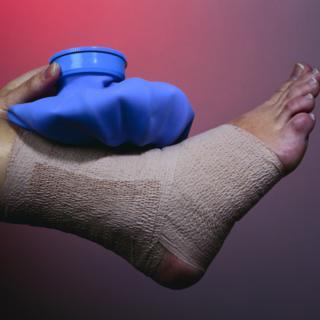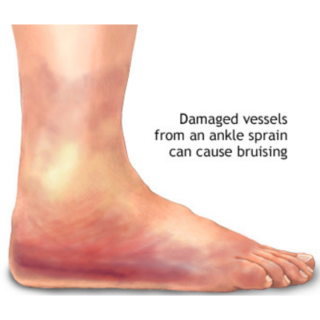 The ankle joint is made up of three bones, the tibia, fibula, and talus, forming a socket in which the ankle joint moves. Ligaments connect bones like thick rubber bands so that joints are stable and function properly.
The ankle joint is made up of three bones, the tibia, fibula, and talus, forming a socket in which the ankle joint moves. Ligaments connect bones like thick rubber bands so that joints are stable and function properly.
When an ankle is sprained, a ligament is either stretched, partially torn, or completely torn. Muscle and tendon structures surround the ligaments allowing walking and running. Blood vessels, nerves, and skin overlie the ligaments and tendons. The ankle joint allows the foot to move. Just below the ankle joint is a ball and socket joint that allows inward and outward motion.
Ankle Sprain Symptoms

Ankle sprain symptoms vary. Often, the ankle is tender, swollen, discolored and can be quite painful to touch. Walking is usually hampered and may become more difficult depending on the severity of the sprain. Instability may occur, especially when ligaments are torn.
Ankle sprains are classified by “types” and range from mild to moderate to severe. Classifying ankle sprains helps the podiatric foot and ankle surgeon diagnose the specific structures involved in the injury. This also helps determine appropriate treatment plans for each type of ankle sprain. Type I ankle sprain, the least severe when ligament fibers have been stretched or slightly torn. In Type II sprains occurs these fibers or ligaments are completely torn. Type III, the most severe, occurs when the entire ligament is torn and the ankle joint is severely unstable. Fractures of the ankle or foot bone require immediate diagnosis and attention.
Diagnosis
The doctor examines the ankle to identify the type of sprain and determine the best treatment. X-rays or specialized X-ray views of the ankle and foot may be used to reveal any fractures, dislocations or instability of the joint. Less frequently, more sophisticated testing is necessary to determine soft tissue injuries. For example, computerized tomography (CT) and magnetic resonance imaging (MRI) give detailed views of the bone and soft tissue structures around the ankle joint.
